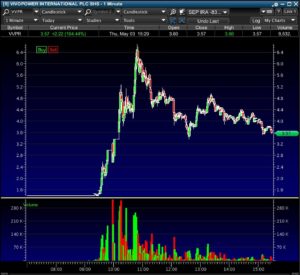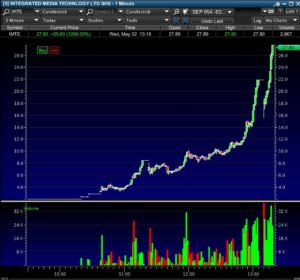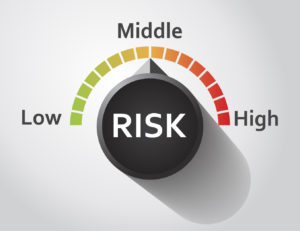I’ve been trading penny stocks for almost 20 years and a lot has changed since I started.
Naturally my strategy has evolved over time – and it has changed dramatically again, I’ll get more into that later. Maybe you’ve heard the term “penny stocks,” but you’ve never really investigated it further.
Perhaps your friends have discussed their investments in penny stocks over the watercooler, yet you didn’t have anything to add to the conversation.
While penny stocks aren’t your only option for investments — far from it! — they’re also not deserving of dismissal. Learning about how these stocks can round out your portfolio and help you become a more successful investor.
In the business world, entrepreneurs have discovered the power of small business. Likewise, investors have found plenty of wealth-building opportunities by investing in smaller, less liquid companies.
In this guide, I’m going to walk you through penny stocks in as much detail as possible so you can make more informed decisions.
Download a PDF version
of this post as PDF.
Table of Contents
What Are Penny Stocks?

A penny stock is any stock that trades for less than $5 per share. The SEC used to define it as a stock that traded for less than $1, but inflation has kept up with the market.
You often won’t find penny stocks on the major market exchanges, such as the New York Stock Exchange (NYSE) or the NASDAQ. Instead, they’re often traded through the OTCBB and the pink sheets (which we’ll get into more later).
While many investors consider penny stocks to be high-risk investments, that isn’t always the case. And as you probably, know, the counterpoint to a high-risk investment is the potential for high reward. If you trade carefully based on research and market history, you can turn penny stocks into profitable investment vehicles.
Furthermore, since the stocks cost less than $5 per share, you can mitigate your risk by trading smaller numbers of shares — at least at first.

Penny Stocks Definition:
As mentioned above, the SEC defines a penny stock as any stock that trades at $5 per share or less. These stocks also have other things in common, such as the following:
- Highly speculative: This means that the stock has a high-risk, high-reward balance. If the stock does well, you have a good chance of making excellent returns.
- Small cap: Penny stocks are generally tied to small capitalization markets. In other words, the company has a relatively low stock valuation — under $2 billion, in most cases.
- Large bid-ask spread: This means that there is a large difference between the asking price and the bid price. In other words, the amount someone is willing to pay is much higher than the price at which someone else is willing to sell.
What Are Pink Sheets?
Think of pink sheets as the OTC version of large market exchanges. Every day, the National Quotation Bureau publishes a pink sheet with the bid and ask prices for penny stocks and other stocks that aren’t traded on the larger market exchanges.
They were named because of the pink paper on which they were printed, and the stocks traded therein can be identified by the “.PK” added after their stock symbols.
These days, though, brokers can access the Electronic Quotation Service to check on bid and ask prices in real time. Instead of relying on a daily publication, they can make decisions quicker.
While the pink sheets don’t contain as many stocks as those on the NYSE or NASDAQ, there are still more than 10,000 companies that trade in this manner. Most people now refer to the Pink Sheets as the OTC Markets Group.
What is Penny Stocks Trading?

Penny stocks trading refers to the activity of actively trading penny stocks on markets like the OTCBB and OTC Link. The types of stocks you can find within the Pink Sheets are just as varied as in any other market. The only difference is the extremely low price of each share.
To trade penny stocks, you’ll need an experienced, knowledgeable broker. Some brokers charge extra if you want to trade a large number of shares in a single transaction, while others limit the number of trades you can make in a day.
When selecting a broker or brokerage, go through a rigorous screening process. Find out exactly how much you’ll pay for the broker’s services and whether there are any limits or surcharges related to trading.
How Do I Get Started With Penny Stocks?
The best way to get started with penny stocks is to find a broker and educate yourself on the market. Learn the language and jargon, the types of companies that trade in the OTC market, and as much information as you can about micro- and mid-cap companies.
You should have a specific goal and strategy in mind before you begin trading. Since penny stocks tend to be more volatile, you don’t want to go into this type of investment blindly.

Start with sectors. To which are you most strongly drawn? Next, move on to markets. Figure out which are performing well and which you understand best. From there, you can narrow down your options to individual stocks. Just remember that you shouldn’t marry yourself to a particular stock.
Biased Recommendations
One thing you have to watch out for when it comes to penny stocks is the biased recommendation.
You might have heard of influencer marketing. It happens when a company pays a popular social media user to promote its products. The influencer receives a flat fee for tweeting or posting on Instagram, for instance, and the company gets access to the influencer’s audience.
This also happens in penny stock trading. A company that wants to push its own stocks will pay someone in the industry to send out social media posts, emails, and press releases that don’t necessarily look like advertisements.
If you see such recommendations, look for signals that the person might have been compensated for it. By law, they should include language about the post or email being “sponsored” by the company.
Offshore Brokers

Unfortunately, boiler room operations are also more common than you might think. These schemes involve selling stock to foreign brokers at discounted prices, then selling them back to U.S.-based investors for a handsome profit.
The SEC doesn’t require offshore brokers to register stocks, so it’s easy to get taken in by this type of nefarious scam. It’s even easier when it comes to penny stocks because they’re subject to less oversight and because small transactions can easily fly under the radar.
The main tipoff is a cold call from a brokerage. The person will use high-pressure sales tactics to convince you that you can buy a certain number of shares for a “steal.” Always initiate your own investments instead of agreeing to a transaction after a cold call.
Most Common Questions Regarding Penny Stocks
An educated investor is a successful investor. The more you know about the market and its potential, the faster you can build wealth.
Many investors who don’t have experience with the stock market or with penny stocks in particular have the same questions for their brokers or financial advisors. I’m going to answer those questions here in detail so you have all the information necessary to dip your toes into the penny stock waters.
There are five questions I hear very frequently from other investors:
- Where should I buy penny stocks?
- What techniques do I need to learn to be successful?
- How do you find hot penny stocks to invest in?
- Which are the best penny stocks to invest in?
- Are penny stocks profitable?
Let’s take these questions one at a time so there isn’t any confusion.
Where Should I Buy Penny Stocks?
The first thing you have to realize about penny stocks is that they’re incredibly cheap, so it’s not always profitable to use a live broker. In fact, I recommend against it.
Instead, use an online broker that allows you to make trades for yourself. You know that I’m a huge advocate for learning and studying, so devote yourself to learning as much as you can about the penny stock trade. Knowledge can be money when applied effectively.
Keep in mind that pennystocking is all about generating quick returns. You’re not holding on to these stocks for months or years on end. Instead, you’re actively trading every day to build up your portfolio and increase your wealth. Therefore, you need a strong online broker to make sure you don’t get conned out of your cash.

What Are the Best Brokers to Buy From?
There are a few online brokers that I can recommend after personally using them.
First of all, eTrade is definitely a good bet. It’s a huge firm that has helped thousands of people build their wealth. I’m also a fan of Interactive Brokers, so see this blog post for more details on the best brokers.
What Techniques Do I Need to Learn to Be Successful?
While penny stocks might get traded at low dollar amounts, you still need some techniques to ensure you don’t lose huge bundles of cash. Sure, you will lose money — it’s part of the process — but you want to make more than you lose.
I use several techniques to trade penny stocks on a daily basis. My students have used them, too, to great success. If you’re willing to learn the logic behind these techniques and apply them to your own trading, you can make money and possibly increase your net worth.
It’s important, though, to find a strategy that works for you. Some people prefer technical over fundamental analysis in most situations. You have to learn to trust your instincts and experience as you gain more perspective on Pennystocking.
In my experience, however, the following techniques are essential to most investors who trade penny stocks.
Penny Stocks Patterns
Trading charts are fundamental to success in Pennystocking. You want to know what a particular stock looks like over time so you can spot patterns and anticipating ups and downs in the market.
Lots of different types of charts exist, and as you gain exposure to them, you’ll figure out which ones are more informative based on your learning style. No matter what charts you follow, though, you’ll be able to visually assess a penny stock’s performance.
I’m particularly fond of the candlestick pattern charts. They can be either extremely complex or highly simplified depending on the types of information used to form the chart. You can recognize them by their candlestick shapes with the accompanying wicks.
Technical Analysis
In penny stocks, as with other types of stocks, there are two basic types of analysis. Technical analysis largely involves studying charts, finding patterns, and making trades based on forecasts.

In many cases, technical analysis is best for pennystocking because it’s designed for shorter-term trading. In other words, if you’re buying and selling stocks within minutes or hours, you don’t want to bother with fundamental analysis too much (which I’m going to describe in a minute).
True-blue technical analysts believe that all the information they need can be found in the charts. In some ways, they’re right. However, technical analysis also assumes that future patterns will mimic past patterns.
It’s possible for a stock to bottom out suddenly with no warning in the charts. This is often as a result of news about the company or other changed financial matters.
Fundamental Analysis
While technical analysis focuses on charts and graphs, fundamental analysis focuses more on a given company’s financial statements. Fundamental analysts want to know whether a company is in debt (and for how much), what its cash flow looks like, how many products or services it sells, and more.
Remember, penny stocks are attached to smaller companies. They have low liquidity, high volatility, and limited products or services. Paying attention to details can help you make more effective trades.
For instance, you would look differently upon a stock for a company that has just received a massive influx of VC capital than one that has taken on a huge amount of debt.
As I mentioned above, fundamental analysis is most often used for long-term trading. The investor wants to hang on to the stock for a long period of time to maximize returns.
Day Trading Penny Stocks
Day trading refers to the practice of buying and selling shares in a company on the same day. It’s often linked to penny stocks, though investors can also day trade on the NASDAQ, NYSE, or AMEX.
Since penny stocks have such high volatility and are so cheap to buy, you can earn small returns through frequent day trading. If you’re constantly monitoring companies’ performance and jumping on stocks in a so-called growth stage.
This isn’t to say that all penny stocks move quickly. Some don’t. That’s why you have to learn the technical aspects of pennystocking. You’ll know when to hold off on selling, when to sell short, and when to sell right away.
Day trading is great for pennystocking newbies because it eliminates risk. For instance, stock can fall precipitously overnight, so if you’re able to get out before the market closes, you’re less likely to lose money.
Furthermore, you’ll learn faster. Day trading forces you to make quick decisions and pay attention to the market. There’s no better teacher than experience.
How Do I Find Penny Stocks to Invest In?
Market research is your best friend. The more you know about companies on the Pink Sheets, the easier it becomes to identify potential good buys.

There are many reasons to invest in a penny stock. For instance, if you’re playing the long game, you might notice an economy-related drop in stock. If you know that market conditions will likely rally, you can invest in the company at less than $5 per share, then sell up when the stock eventually rebounds.
You’ll want to examine the charts for any company you consider. It’s often helpful to start your search by sector, then market, then individual stock. You’ll get a better idea of competition, performance, financials, and more.
Alternatively, you can check out my blog and other publications to learn about penny stocks that might be worth your time. Just remember that compensated suggestions aren’t worth anything. You want unbiased recommendations.
How To Invest in Penny Stocks and Profit More?
My advice is to use the limit order strategy to trade penny stocks. With this type of trade, you decree that you’ll only share a stock at a particular price point. It’s the exact opposite of market orders, which are subject to the whims of the market, as the name implies.
Finding a cheap, but solid broker like these penny stock brokers is the best strategy if you’re starting with very limited capital. Some of the brokers I’ve worked with have had starting minimums of as much as $30,000. If you’re not in that position, you need a lower-level broker.
Just remember that penny stocking is a way to build wealth steadily over time. Instead of relying on a stock that trades at $130 per share to make you money over a six-month trek, you’re trading fast to make the most of everything you buy and sell.
What Are Good Stocks to Invest in Right Now?
People often ask me about where they should put their money this very minute. It’s a common question, especially among amateur investors, because nobody wants to take a huge risk right out of the gate.
If you’re risk-averse, you might struggle to jump into the penny stock deep end. That’s why I recommend investing conservatively. You don’t have to buy tons of shares just because each share is cheap. In fact, that’s a good way to lose a lot of money in one fell swoop.
Instead, I recommend going in conservatively and paying careful attention to market fluctuations. Like me, experience will teach you what patterns to look for and how to evaluate specific opportunities.
If you’re day trading, you can take a few more risks with smaller amounts of money without huge potential losses. When you’re just learning how to invest in the stock market, you need all the experience you can get.

Are Penny Stocks Under $1 Profitable?
Back in October 2017, the publication Money Morning highlighted 10 penny stocks that were trading under $1. That doesn’t sound too impressive, right?
However, author Alex McGuire pointed out something truly astonishing: Those penny stocks showed gains of as much as 1,033 percent.
You won’t find those kinds of gains on blue chip stocks — at least, not on a regular basis. And it’s true that every penny stock won’t perform that well, but when you find one, it can have a huge impact on your portfolio.
This question is too broad to answer definitively. Some penny stocks will result in losses, and others will sell at disappointingly low gains. But that’s not the point.
You have to focus on a pennystocking strategy — in other words, many trades over many months — instead of a single “big win.”
The question of whether or not penny stocks can be profitable under $1 misses the point. The real question is whether or not you can trade those stocks for a profit collectively.
Successful Tips To Invest In Penny Stocks Right Now
Lots of so-called financial gurus charge several thousand dollars for their pennystocking tips. That’s not me. If you want to know the rundown, I’ll give it to you.
Ultimately, my goal is to help you become a more effective trader. If you can learn from my experience, I’ll have met my goal.

My investment career has spanned nearly two decades, and I’ve multiplied my net worth many times over. Since I’ve generated the bulk of my success through pennystocking, I’ve learned a few things that might help you become successful, too.
The important thing is to keep learning. I don’t know everything about investment strategy, so I’m always reading financial publications to expand my knowledge base and increase my chances of future success.
The more knowledgeable I get, the easier it becomes to weed out the poor advice from the gems. All of this studying gives me an advantage over other traders who simply go in blind.
If you’re thinking about becoming a trader, you need to know the basics of how to succeed in this market.
Don’t Sell Short
I’m a big fan of short selling, but only in certain situations.
A short sell is sort of like borrowing stock. You have to buy a margin account with your broker, and you then borrow the shares to invest in the stock. In a bear market, you can generate huge profits with this strategy.
The problem is that your risk increases, too.
When you short sell, you run the risk of not just negating your initial investment, but going into debt.
Let me explain.
In a typical transaction, your return on an investment can range from $0 (loss of your investment) to any amount of profit. During a short sell, your profit can go negative, which means that you’ll owe money in the transaction.
You’ll have to pay a fee to your broker in exchange for lending the stock.
If you’re new to investing, you might want to avoid short selling. While there is tremendous potential for profits to be made, there are also significant risks.
Trade Only Penny Stocks with Volume
Volume is an essential element of any penny stock. I prefer to limit my transactions to stocks that are trading at least six-figure shares per day.
The volume demonstrates activity for that particular stock. When volume is low, you’re less likely to be able to sell your shares when you want.
It’s all about position when it comes to penny stocks, especially when you’re engaging in day trading. If you can’t get out quickly to maximize your profit, you put yourself in a negative position.
You also want to consider volume with regard to price. If a stock is trading at less than $1 and with fewer than 100,000 shares per day, it’s probably not a safe bet. You want lots of action on the stock itself as well as a healthy price point.
Enforce Mental Stops
It’s extremely important to make sure you have standards in place for loss control. Even though you’re investing very little money per share in a penny stock, you don’t want to lose more than necessary.

That’s where mental stops come in. A mental stop (also called a soft stop) is a situation in which you decide a level at which to sell your stock. You don’t set up the computer to execute the sale, but you mentally know when you’re willing to get out.
It takes into account market fluctuations. For instance, a stock might drop below your mental stop point, but market conditions suggest it will rally. In that case, you’ll pay more attention to the stock and sell if you don’t believe the price can recover.
This is different from a fixed stop, which is a situation where you instruct your broker to sell a given stock if it drops below a certain price point.
Don’t fall for the Promotional Pumps!
A pump and dump occurs when an investor buys up lots of shares of a penny stock, then sells as soon as activity begins to grow. That’s not exactly unethical, but promotional pumps are.
A promotional pump is when a company hires a well-known individual with a solid platform to promote a particular stock. The promoter sends out emails, tweets, Facebook posts, and blog articles about the stock, encouraging his or her audience to buy it.
This is artificial at best because the promoter receives payment for that service. It’s not a legitimate recommendation because the promoter has no skin in the game.
Only listen to recommendations by people who have no financial interest in the stock other than their own investment. That way, you know you aren’t getting suckered into a poor deal.
Recognize a Raw Deal
Sometimes, an investment just doesn’t go your way. You follow it for hours or days, expecting it to turn around, but it doesn’t. Trust me. We’ve all been there.
You have to know when to get out.
Sure, you could sell a stock today that has tremendous gains tomorrow. However, that’s better than failing to sell today and watching it plummet overnight.
Conservative investments will keep your wealth safe.
Look For Penny Stock Success Stories
Another great way to further your education and success is to piggyback on others’ success. You can find tons of information on my website about students of mine who have multiplied their wealth exponentially.
It’s important to consider the source, of course. You don’t want to blindly follow someone’s advice without any proof. People who publish their trades (whether good or bad) and provide insight into their strategies are worth their weight in gold.
Learn How to Invest in Penny Stocks With My Top Students
If you’re interested in learning how to trade penny stocks successfully, join my top students in my Millionaire Trading Challenge. It’s a great way to motivate you to begin trading aggressively and to learn as quickly as you can.
You can also learn from me in other ways. Check out my DVD collection, watch the videos available for free on my website, and follow my blog. I’m always sharing tips and tricks to help other investors maximize their investments.
Listen To Great Tips and Read The Disclaimers
Studying your craft is essential to becoming a well-versed trader. As long as you’re learning, you’re becoming better.
Make sure you read any disclaimers that come with stock suggestions. People claiming to be gurus will shout far and wide the benefits of investing in a particular company, but you’ll often see a disclaimer on their post or email that tells you they’ve been compensated for their recommendation.
That’s not the kind of advice you want to follow.
Avoid Promotional Hype
Lots of investors get their hearts mixed up with their heads. They encounter a penny stock, for example, that is “revolutionizing” the green aspects of its industry. They’re passionate about eco-friendly commerce, so they invest.
I’m not saying that you shouldn’t support companies that mirror your values and beliefs. However, you have to separate your heart from your investments.
Just because a company espouses certain beliefs or values doesn’t mean it will succeed economically. As an investor, you have to weigh every transaction on its merits. Do you stand to generate profit? If not, move on.
Embrace Failure
Nobody goes into trading without eventually failing. It’s inevitable. None of us has a crystal ball to tell us which stocks will skyrocket and which will plummet.
I’ve failed lots of times (and blogged or spoken about it). There’s no shame in making a mistake because all we can do is act on the information given to us.
If you’re not willing to fail, you need to pursue something else. Otherwise, you’ll simply be disappointed.
There’s an upside to failure, though. Failure makes you stronger, smarter, and more experienced. It colors every decision you make in the future.
Keep a Diary

Did you know that I keep a diligent diary of all my trades? It’s the best way I know to track my progress and learn from my successes and failures.
If you’re not into the analog approach, track your trades on Profit.ly. It’s an excellent electronic solution to organization, and you can see more visual representations of your trades.
The important thing is to document your progress and learn from what you’ve done in the past. Yesterday’s mistake can become tomorrow’s enormous profit.
Keep It Real
I talk a lot about the toys I buy, the vacations I take, and the gifts I bestow on loved ones. When you earn lots of money, you have the right to celebrate it — publicly, if you so desire.
But that doesn’t mean I advocate a frivolous lifestyle. Responsibility is essential for any type of trading because you don’t want to get lost in the hype.
Don’t invest money you can’t afford to lose. If the last few dollars in your bank account need to go toward your rent, pay the rent. Don’t invest that money on penny stocks with the hope of making money.
Your safety, well-being, and financial solvency should always come first. Yes, you can make millions of dollars in the stock market, but you can’t assume an “it will all work out” mentality. Invest only money that you can stand to lose.
Advantages and Disadvantages of Investing in Penny Stocks
Over the years, I’ve become intimately familiar with the pros and cons of investing in penny stocks. If you know anything about me, you already know that I find the “pros” more revealing than the “cons.”
It’s called an “investment” for a reason. When you invest your money, there’s no guarantee that you’ll get your money back. It’s different from a loan, which includes some time of surety that guarantees you’ll be paid back (or at least have recourse against the borrower).
Investments are different because there’s a certain element of risk. You can either lose your money or make money on the transaction. For many investors, the risk is part of the thrill. It’s like an adventure — one that takes place in ones and zeros instead of far-off lands.
With that said, I’ve made the lion’s share of my money with penny stocks, and I trust them to help me not only build wealth, but also sustain it. In fact, I find pennystocking more lucrative than investing in more expensive stocks.
But to make sure you’re familiar with the ins and outs of the business, let’s look at the advantages and disadvantages associated with penny stocking.
The Benefits of Investing in Penny Stocks
I’ll start with the benefits of penny stocks. They’re my favorite.

Low Capital Investment
You don’t need to be rich to invest in penny stocks. Since they cost less than $5 per share, they’re highly egalitarian. Anyone has a chance to make their fortune in this game.
I started my investment career with just under $13,000. Many people don’t have that kind of capital at their disposal. What if you want to start investing with just $1,000 or $500? You can’t very well gain experience and diversify your portfolio if you’re buying stock that costs $100 per share.
Diversification
Building on the last point, let’s discuss the importance of diversification. I like a diverse portfolio because it allows my wins to make up for any losses. Think of it as insurance for your net worth.
Since penny stocks don’t cost much per share, you can diversity far more effectively. Plus, you gain access to OTC stocks more easily because the brokers involved with these trades have lower minimums as well as lower brokerage fees.
Fast Movement
I’m also fond of penny stocks because movement happens quickly. If you look at charts and graphs for penny stocks, you’ll see rapid fluctuations. These changes allow you to make quick decisions — ride it out or get out quick.
In many cases, the price of a share of stock can double overnight. If you get out immediately, you’ve generated a 50 percent profit on your investment. Not too shabby for income you generate while you sleep.
Potential Ascension
In some cases, a micro-cap stock can ascend to become a mid-cap stock very quickly. This is the situation where you see returns of several hundred percent.
When it happens, it can vastly improve your wealth and allow you to trade more aggressively in the future because you have more capital.
The Risks of Investing in Penny Stocks
It’s relatively easy to mitigate your risk with penny stocks if you know which pitfalls to avoid.

With that said, there’s no way to avoid risk entirely. I publish all of my trades online, and I don’t disguise my failures. Everyone who invests money will fail — and they might fail often.
The goal is to maintain more wins than failures.
Following are some of the most common risks associated with penny stocking and how to avoid them to the best of your ability.
Invest with lack of information available
Micro-cap stocks, unlike the stocks traded on the major securities exchanges, aren’t regulated by the SEC to any discernible degree. The companies don’t have to submit copious documents to comply with SEC standards.
Consequently, you have to do your own research.
Even a simple Google search can reveal information about a given company. You might read news stories, for instance, about recent mass layoffs or financial difficulties. You could also discover positive information that would make the company a good bet for buying stock.
Join trading communities where investors like you trade information and reveal data that could encourage or discourage trades. Just make sure to validate your sources — and to avoid trusting promoters who get paid to tout a particular penny stock.
Pay attention to the charts. Do you see lots of topping out or bottoming out? Is there a stair-climber pattern? What do the candlestick charts look like?
History isn’t a completely reliable predictor of future trends, but it can help you make a more informed decision with your trades.
Invest with no minimum standards
Pay careful attention to companies that have fallen off the major stock exchanges and into the Pink Sheets. When this happens, there’s often an indication of financial failure within the company.
There are no minimum standards requirements for OTC Link stocks. You’re flying blind in terms of balance sheets, P&L reports, and other documentation.
Since you don’t have access to this data, you have to trust your instincts and experience. If there’s no readily available information on a company, you might not want to consider buying its stock. Stick with penny stocks that have long histories in the market and that have shown positive patterns in the charts.
Invest with lack of history
You’ll also encounter situations where a company has no trading history at all. It might be a brand new company, or it could be a company approaching bankruptcy. Neither is necessarily an indication of future performance.
In this case, you can either mitigate your risk by avoiding those stocks, or you can invest small amounts of money over short periods of time to see how the shares perform. Your risk tolerance should dictate how you proceed.
Invest without liquidity
One of the primary reasons some investors avoid penny stocks is the lack of liquidity. Just because you buy shares of a particular stock doesn’t mean you’ll be able to unload them in the future. There’s a supply-and-demand element to penny stocking.
The other problem is that some savvy (and unethical) investors will attempt to manipulate the penny stocking game. You have to pay attention to steep increases in trading activity with no discernible reason behind them.
The Potential Payoff of Penny Stocks
I’ve made millions of dollars off penny stocks. So have many of my students. Even more of my students have generated six-figure profits from pennystocking.**

In other words, there’s huge potential profit in penny stocks.
Many of the failure stories I’ve heard have involved going “all in” on a penny stock. The investor gets a great tip from a penny stock promoter and buys a ton of shares, assuming he or she will get rich.
In most cases, that doesn’t happen.
These promoters are paid to inflate the public opinion of a given stock. In exchange for cash, they’ll tell their audiences to invest in this one specific company to generate a huge influx of cash. When the stock inevitably plummets, there’s no recourse for the unwary investors who followed the bad advice.
You also need a sound strategy in place. Sure, some penny stocks generate huge returns, such as 800 or 1,000%. But that’s rare.
If you’re willing to accept a profit of 30 percent and get out while the stock remains up, you’ll generate steady profits (and negate any losses).
Other Questions That Every Penny Stock Trader Has Already Asked
I’m often asked questions about the validity and risk associated with penny stocks. Lots of misinformed financial analysts have given pennystocking a bad name, either because of the risk or because of the people who try to game the system.
I don’t like fear mongering. It sends the wrong message to people who want to multiply their net wealth and protect their families against financial distress.
Following are three questions I hear on a regular basis and my honest, no-holds-barred responses.
Are penny stocks worth the risk?
Risk is always relative.
Let’s say that you’re worth $10 million dollars and you have an opportunity to invest in a piece of real estate that costs $500,000. That’s not a huge risk compared to your net worth, and if you know the real estate market will increase the property’s value to $1 million over the next 12 months, you’ll be willing to take that risk.
With all else being equal, though, you might consider the deal a much higher risk if you were worth only $500,000. A natural disaster could destroy the market forecast, putting you upside-down in a mortgage.
These same principles apply to penny stocks.
Yes, they’re a greater risk than blue chip stocks (which we’ll discuss later), but you’re risking a fraction of the cash. Investing $2 in a penny stock is much different than investing $170 in Apple.
That’s why I advise my students to at least get their start with penny stocks. It’s a great way to increase your risk tolerance without putting yourself in overt financial danger.
Does anyone successfully invest in penny stocks?
There wouldn’t be a market for penny stocks if it wasn’t possible to successfully invest in them.
Think about it this way: There are both small and large businesses. Small business owners often generate a profit — sometimes a huge profit — but their revenue can’t compare to that of Walmart or Toyota.
You also have to consider the ratio. Let’s say that you buy 10 shares of a stock that’s trading at $1. You’ve just invested $10. That’s not much money, right?
Now, let’s say that stock increases to $5 per share over the following two weeks. If you sell then, your takeaway becomes $500 — a pretty heft profit.
That’s not how it always happens, but it happens often enough.
Although you’re betting on a higher risk game, you’re betting less money. As long as you diversify your portfolio and continue to trade every day, you’ll see your net worth climb.
Do people get rich trading penny stocks? Can you make money in penny stocks?
I’m often asked whether you can actually generate serious wealth by trading penny stocks. The answer is a resounding YES.**

I’m living proof of that fact. Although I’ve dabbled in long-term stock trading, I’m best at short-term trading, including penny stocks. In fact, most of my teachings are related to penny stocks, and that’s how most of my students have earned their own wealth.**
It’s not a get-rich-quick scheme. Some people take six months before they’re able to considerably multiply their initial investments, while others might spend a year or more getting the hang of pennystocking.
Still, it’s faster to earn wealth this way than with a nine-to-five job, especially if you follow the tips and strategies I teach. You don’t have to start from the beginning. You can study and figure out the game before you even enter the market.
What As the Penny Stock Regulations?
There are far fewer regulations in the penny stock market than on the major stock exchanges. The SEC doesn’t monitor these companies nearly as closely, and the OTC exchanges don’t impose the same requirements in terms of paperwork or proof.
For some investors, these facts make pennystocking too risky. They worry about getting sold bad stock based on faulty information, but that can happen at any time. That’s why I tell my students to invest conservatively and pay careful attention to the market.
With that said, the SEC does impose certain rules for penny stocks.
The SEC’s Rules for Penny Stocks

It’s essential to work with an ethical broker who follows the SEC’s rules and provides you with appropriate disclosure, documentation, and statements. You don’t want to go with an overseas broker or someone you haven’t researched.
For penny stocks, I generally recommend low-cost online brokers, especially for amateurs.
Of course, you should still familiarize yourself with the SEC’s rules with regard to trading penny stocks. Following are five of the most pertinent rules you should be aware of.
1. Sales Practice Requirements §240.15g-9
The SEC wants to make sure that brokers and dealers aren’t able to manipulate their customers to their own advantage. Consequently, brokers have to abide by sales practice requirements, which include the duty to “approve” the customer.
This basically means that the broker has to assess whether or not the customer’s financial goals and means make him or her a suitable candidate for pennystocking. The SEC doesn’t want brokers to work with people who might game the system or create a financially dangerous situation for other investors.
2. Disclosure Document §240.15g-2
I mentioned before that penny stocks are considered relatively high-risk. In other words, their volatility make them good candidates for creating big losses. However, for investors like myself, that risk is countered by the opportunity for incredible financial rewards.
Still, the SEC wants consumers and investors to understand that risk, so brokers have to give their customers a standardized disclosure document. It explains the risks of trading penny stocks and ensures the investor understands any potential pitfalls.
3. Bid-Offer Quotations Disclosure §240.15g-3
Like in any transaction, you want to know what you’re paying for and what the quote is on the marketplace. In this section of the SEC’s rules, people who broker sales in penny stocks have to provide the investor with the bid-offer quotations.
4. Compensation Disclosure §240.15g-4
Brokers must also, under SEC rules, provide the investor in writing with his or her compensation schedule. In other words, how much money is the broker earning?
Some brokers charge a flat fee, while others charge by the transaction or even the share. You should take these into consideration when choosing a broker for your own investment strategy.
5. Monthly Accounts Statements §240.15g-6
Every month, your broker must send you account statements that detail each transaction and the current state of each penny stock.
This is the best way for you to keep abreast of your own transactions, though you should also keep your own journals.
When Is a Penny Stock Not a Penny Stock Anymore?
A penny stock stops being a penny stock when its share price rises above $5. Sometimes this happens permanently; in other cases, it’s a temporary increase, and the stock will dip back into penny territory shortly thereafter.
Many people mistakenly believe that penny stocks are just future monoliths like Apple. This is rarely the case. Entrepreneurs have to struggle daily to keep their balance sheets in check and to forestall catastrophe. Companies behind penny stocks sometimes go under.
What is a blue chip stock?
You might think of a blue chip stock as the exact opposite of a penny stock. While a penny stock belongs to a small, often new company, blue chip stocks belong to large companies with long track records. Their market capitalization is typically many billions of dollars.
In most cases, a company with blue chip stock is one of the top three to five competitors in its sector. We’re talking about companies like Apple, IBM, and Ford.
Of course, the shares for blue chip stocks are going to be far more expensive than those of penny stocks. Most people who buy blue chip stocks intent to hold them for a significant period of time to maximize returns.
With that said, I don’t believe in hanging on to stocks forever. Nor do I think that blue chip socks are a risk-proof investment.
Think of all the companies that have gone bankrupt over the last two decades. General Motors is a prime example. Just because a company looks big and stable on the outside doesn’t mean it’s not rotting from within. That’s why studying financial documents is essential for more expensive stocks.
The Final Question: Who is the best penny stock teacher?
I can’t tell you how important it is to find a penny stock teacher who not only has the necessary knowledge to fuel your growth, but who also has the discipline necessary to protect you from making bad choices.
There are a lot of charlatans out there. Some people just want to make money, and they don’t care if they sabotage others in the process. That’s not me. I’ve developed my reputation through brutal honesty and that’s why I have so many self-sufficient and consistently-profitable trading challenge students.**
The best penny stock teacher helps you keep up with the trends, make recommendations, and share his or her trades — even the losses. (Just so you know, I do all those things).
If you’re interested in learning about penny stocking, I’m here to help. I’ve created several DVDs on various trading and investing topics that you might want to check out, and I offer a few courses to give you more in-depth information on a regular basis.
Who is Timothy Sykes?
I’m a guy who knew he wanted to achieve financial freedom, and the way I did it was through pennystocking. When I was in college, I started trading with just over $12,000. Now I’ve made nearly $5 million in trading profits.**

How did I do it? I studied, paid attention, tracked my progress, and learned how to read charts. I also found mentors in the industry whose successes inspired me.
More than 7,000 students are now learning my techniques through my coaching programs. I’m not afraid to make enemies; if people spread misinformation or attempt to game the system, I’ll call them out so other traders don’t suffer because of them.
I great up in a middle-class family, but I knew I wanted to make myself a fortune. As a result of my success, I’ve invested in plenty of toys, shared my wealth with family members and charities, and taken quite a few luxurious vacations.
More importantly, I have peace of mind.
A Brief Look at My Journey
I made my first million while living in the dorms in college.** Since I’m a self-taught trader, I used my free time to learn everything I could about pennystocking, then I improved upon the techniques I learned based on experience.
I turned $12,415 into $4.7 million, but you don’t have to achieve that level of success to become financially independent.**
Over the years, I’ve built communities and courses to help people learn how to trade more efficiently. I’ve been interviewed by Larry King, featured in magazines like Young Money, and found my name on lists of youngest millionaires.
Of course, I skipped a lot of college classes to achieve what I did. My Bar Mitzvah money became $2 million**, and I started a hedge fund during my senior year.
I’ve learned a lot along the way. For one thing, I’m better at penny stocking than long-term trading. For another, I have a gift that can help people.
Millionaire Trading Challenge
I’m a big fan of challenging yourself. The more you push yourself to learn and grow, the faster you can build your wealth.
I’m also passionate about helping other people achieve financial freedom. The definition of financial freedom varies from one person to the next, but seven figures sounds pretty good to just about everyone.

That’s why I started the Millionaire Trading Challenge. You’ll get one-on-one time with me, tons of advice and tips, and a chance to prove that you can turn your current liquidity into seven figures or more.**
Whether you want to replace your day job with full-time trading or simply want to make extra cash for your future, the Millionaire Trading Challenge has what you need. As long as you apply what you learn and continue to grow, you’ll continue to multiply your capital.**
Many of my students have achieved great wealth.** I’ve also been featured widely in the media, from CNN to Steve Harvey. If you want to learn my tools of the trade, sign up for the Millionaire Trading Challenge and start trading yourself to success.

Conclusion
Now that you have a broad introduction to penny stocks, you’re ready to start trading. Follow my blog and videos to keep adding to your knowledge base.
Penny stocks are stocks that trade at fewer than $5 each. They’re not subject to as much regulation as the major stock exchanges, and they tend to demonstrate high volatility.
There’s more risk in the penny stock market, but there are also more opportunities for rewards. I’m living proof of that.
What you need to know is that education is your best asset. If you’re not willing to study hard, you won’t turn your first few thousand dollars into six-figure gains. It’s just not possible — unless, of course, you’re very lucky.
Follow my tips for analyzing penny stocks, avoiding potential risks, and staying up to date with the market. You’ll thank yourself.
Click here to see the full story










